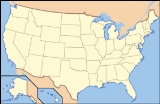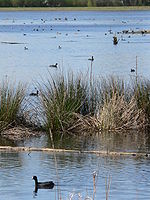
Ankeny National Wildlife Refuge
Encyclopedia
Ankeny National Wildlife Refuge is located in the fertile Willamette Valley
of northwestern Oregon, 12 miles (19 km) south of Salem
. The valley was once a rich mix of wildlife habitats. Valley wetlands were once extensive, with meandering stream channels and vast seasonal marshes. Today, the valley is a mix of farmland and growing cities, with few areas remaining for wildlife.
 The Refuge is situated in open farmland near the confluence of the Santiam
The Refuge is situated in open farmland near the confluence of the Santiam
and Willamette
rivers in the middle of the broad Willamette Valley. Elevations range between 180 to 290 feet (55 to 90 m) MSL
. The Willamette Valley, with its mild, rainy winter climate, is an ideal environment for wintering waterfowl. The Refuge consists of 1,765 acres (7.143 km²) of cropland
, which provide forage for wintering geese, 600 acres (2.4 km²) of riparian zone
forests, and 500 acres (2.0 km²) of shallow water seasonal wetland
s.
As with the other refuges within the Willamette Valley National Wildlife Complex, the primary management goal of Ankeny National Wildlife Refuge is to provide high quality wintering habitat for geese, especially the Dusky Canada Goose
(Branta canadensis subsp. occidentalis), to ensure healthy, viable goose populations while minimizing goose browse damage to crops on private agricultural lands. Unlike most other Canada geese, Dusky Canada Geese have limited summer and winter ranges. They nest on Alaska
's Copper River Delta and winter almost exclusively in the Willamette Valley. Habitat loss, predation, and hunting caused a decrease in their population.
The Willamette Valley refuges incorporate an intensive cooperative farming program in order to provide high protein browse (annual ryegrass
, perennial ryegrass and fescue) for seven subspecies of wintering Canada geese, with primary emphasis on the Dusky subspecies. Under cooperative agreements, area farmers plant refuge fields. Some fields are planted annually and others are mowed or burned to produce the tender, nutritious grasses preferred by geese.
The geese also need water for resting and foraging habitat. Many refuge wetlands occur naturally; others are created by dikes and levees. In some low-lying areas of the refuge, wetlands that were drained or channelized by previous owners have been restored to increase diversity and desirability of habitat for wildlife. The majority of wetlands are being managed as moist soil units, to promote growth of wetland food plants (millet, smartweed, sedges, etc.) used as food by waterfowl and other wildlife.
By resting in undisturbed areas on the refuges, wintering geese regain energy reserves required for migration and nesting. This sanctuary also reduces depredation problems on neighboring private lands by encouraging waterfowl to use refuge resources. Because of their need for a quiet resting area, waterfowl habitat is closed to public entry while the geese are in residence in order to minimize human disturbance. Recently, the refuge has increased efforts to restore and expand riparian forest and wet prairie habitats.
Ankeny NWR also provides habitat for a wide variety of other bird species, as well as mammals, reptiles and amphibians. Wildlife and wildlands observation, photography, hiking, and environmental education and interpretation are the major public use activities allowed on the Refuge.
Visitor facilities include Ankeny Hill Overlook on Ankeny Hill Road and Eagle Marsh Kiosk on Buena Vista Road. Trails include Pintail & Egret Marsh Boardwalk and the Rail Trail, both on Wintel Road.
Willamette Valley
The Willamette Valley is the most populated region in the state of Oregon of the United States. Located in the state's northwest, the region is surrounded by tall mountain ranges to the east, west and south and the valley's floor is broad, flat and fertile because of Ice Age conditions...
of northwestern Oregon, 12 miles (19 km) south of Salem
Salem, Oregon
Salem is the capital of the U.S. state of Oregon, and the county seat of Marion County. It is located in the center of the Willamette Valley alongside the Willamette River, which runs north through the city. The river forms the boundary between Marion and Polk counties, and the city neighborhood...
. The valley was once a rich mix of wildlife habitats. Valley wetlands were once extensive, with meandering stream channels and vast seasonal marshes. Today, the valley is a mix of farmland and growing cities, with few areas remaining for wildlife.

Santiam River
The Santiam River is a tributary of the Willamette River, about long, in western Oregon in the United States. Through its two principal tributaries, the North Santiam and the South Santiam rivers, it drains a large area of the Cascade Range at the eastern side of the Willamette Valley east of...
and Willamette
Willamette River
The Willamette River is a major tributary of the Columbia River, accounting for 12 to 15 percent of the Columbia's flow. The Willamette's main stem is long, lying entirely in northwestern Oregon in the United States...
rivers in the middle of the broad Willamette Valley. Elevations range between 180 to 290 feet (55 to 90 m) MSL
Sea level
Mean sea level is a measure of the average height of the ocean's surface ; used as a standard in reckoning land elevation...
. The Willamette Valley, with its mild, rainy winter climate, is an ideal environment for wintering waterfowl. The Refuge consists of 1,765 acres (7.143 km²) of cropland
Farm
A farm is an area of land, or, for aquaculture, lake, river or sea, including various structures, devoted primarily to the practice of producing and managing food , fibres and, increasingly, fuel. It is the basic production facility in food production. Farms may be owned and operated by a single...
, which provide forage for wintering geese, 600 acres (2.4 km²) of riparian zone
Riparian zone
A riparian zone or riparian area is the interface between land and a river or stream. Riparian is also the proper nomenclature for one of the fifteen terrestrial biomes of the earth. Plant habitats and communities along the river margins and banks are called riparian vegetation, characterized by...
forests, and 500 acres (2.0 km²) of shallow water seasonal wetland
Wetland
A wetland is an area of land whose soil is saturated with water either permanently or seasonally. Wetlands are categorised by their characteristic vegetation, which is adapted to these unique soil conditions....
s.
As with the other refuges within the Willamette Valley National Wildlife Complex, the primary management goal of Ankeny National Wildlife Refuge is to provide high quality wintering habitat for geese, especially the Dusky Canada Goose
Canada Goose
The Canada Goose is a wild goose belonging to the genus Branta, which is native to arctic and temperate regions of North America, having a black head and neck, white patches on the face, and a brownish-gray body....
(Branta canadensis subsp. occidentalis), to ensure healthy, viable goose populations while minimizing goose browse damage to crops on private agricultural lands. Unlike most other Canada geese, Dusky Canada Geese have limited summer and winter ranges. They nest on Alaska
Alaska
Alaska is the largest state in the United States by area. It is situated in the northwest extremity of the North American continent, with Canada to the east, the Arctic Ocean to the north, and the Pacific Ocean to the west and south, with Russia further west across the Bering Strait...
's Copper River Delta and winter almost exclusively in the Willamette Valley. Habitat loss, predation, and hunting caused a decrease in their population.
The Willamette Valley refuges incorporate an intensive cooperative farming program in order to provide high protein browse (annual ryegrass
Ryegrass
Ryegrass is a genus of nine species of tufted grasses in the Pooideae subfamily of the Poaceae family. Also called tares , these plants are native to Europe, Asia and northern Africa, but are...
, perennial ryegrass and fescue) for seven subspecies of wintering Canada geese, with primary emphasis on the Dusky subspecies. Under cooperative agreements, area farmers plant refuge fields. Some fields are planted annually and others are mowed or burned to produce the tender, nutritious grasses preferred by geese.
The geese also need water for resting and foraging habitat. Many refuge wetlands occur naturally; others are created by dikes and levees. In some low-lying areas of the refuge, wetlands that were drained or channelized by previous owners have been restored to increase diversity and desirability of habitat for wildlife. The majority of wetlands are being managed as moist soil units, to promote growth of wetland food plants (millet, smartweed, sedges, etc.) used as food by waterfowl and other wildlife.
By resting in undisturbed areas on the refuges, wintering geese regain energy reserves required for migration and nesting. This sanctuary also reduces depredation problems on neighboring private lands by encouraging waterfowl to use refuge resources. Because of their need for a quiet resting area, waterfowl habitat is closed to public entry while the geese are in residence in order to minimize human disturbance. Recently, the refuge has increased efforts to restore and expand riparian forest and wet prairie habitats.
Ankeny NWR also provides habitat for a wide variety of other bird species, as well as mammals, reptiles and amphibians. Wildlife and wildlands observation, photography, hiking, and environmental education and interpretation are the major public use activities allowed on the Refuge.
Visitor facilities include Ankeny Hill Overlook on Ankeny Hill Road and Eagle Marsh Kiosk on Buena Vista Road. Trails include Pintail & Egret Marsh Boardwalk and the Rail Trail, both on Wintel Road.
Refuge Objective
- provide winter habitat for the dusky Canada goose and other migratory waterfowl
- protect, restore and enhance populations of threatened and endangered species
- maintain habitats for indigenous species and perpetuate natural diversity
- provide for environmental education, research, and wildlife oriented recreation

